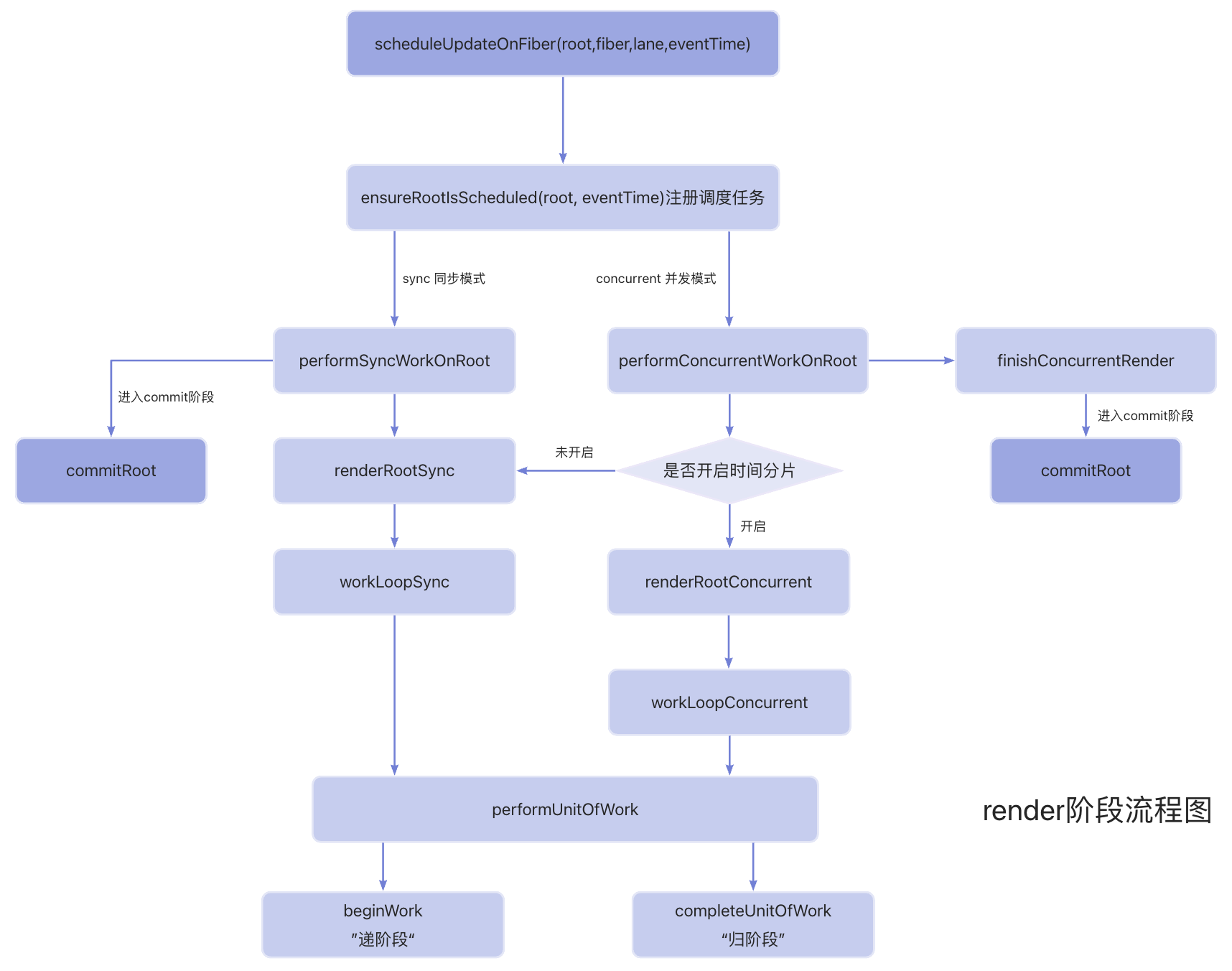React 18 渲染流程
在上一节的源码基础中已经介绍了 React 架构以及 Fiber 架构,本节将主要讲解的是 React 的渲染流程。
初始化阶段

React 的初始化以下面这段代码开始:
jsx
import React from 'react'
import ReactDOM from 'react-dom/client'
import App from './App.jsx'
ReactDOM.createRoot(document.getElementById('root')).render(<App />)
ReactDOM.createRoot是 React 应用初始化的入口,进行一些初始化的操作,返回一个 ReactDOMRoot 实例。
render 调用的是ReactDOMRoot.prototype.render这个原型方法,用于渲染根组件。
主要的流程如下:
- 校验 container 是否合法
- 处理 options 参数
- 创建 FiberRootNode 和 RootFiber,初始化更新队列
- 标记 DOM 对象,把 DOM 和 RootFiber 对象关联起来
- 监听支持的事件
- 返回 ReactDOMRoot 实例
ReactDOM.createRoot
createRoot
createRoot
js
export function createRoot(
container: Element | Document | DocumentFragment,
options?: CreateRootOptions
): RootType {
// 校验容器元素 container 是否合法
if (!isValidContainer(container)) {
throw new Error('createRoot(...): Target container is not a DOM element.')
}
let isStrictMode = false // 是否是严格模式
let concurrentUpdatesByDefaultOverride = false // 是否允许并发更新
let identifierPrefix = '' // 标识符前缀
let onRecoverableError = defaultOnRecoverableError // 错误处理函数
let transitionCallbacks = null // 过渡回调函数
// 处理 options 参数
if (options !== null && options !== undefined) {
// ...
}
// 创建 FiberRootNode 和 RootFiber,初始化更新队列
const root = createContainer(
container,
ConcurrentRoot,
null,
isStrictMode,
concurrentUpdatesByDefaultOverride,
identifierPrefix,
onRecoverableError,
transitionCallbacks
)
/**
* 标记 dom 对象,把 dom 和 RootFiber 对象关联起来
* 将 root.current 挂载到 container 的 _reactRootContainer 属性上
*
* export function markContainerAsRoot(hostRoot: Fiber, node: Container): void {
* node[internalContainerInstanceKey] = hostRoot;
* }
*/
markContainerAsRoot(root.current, container)
const rootContainerElement: Document | Element | DocumentFragment =
container.nodeType === COMMENT_NODE ? (container.parentNode: any) : container
// 监听所有支持的事件
listenToAllSupportedEvents(rootContainerElement)
// 返回一个 ReactDOMRoot 实例
return new ReactDOMRoot(root)
}
createContainer
createContainer
js
export function createContainer(
containerInfo: Container,
tag: RootTag,
hydrationCallbacks: null | SuspenseHydrationCallbacks,
isStrictMode: boolean,
concurrentUpdatesByDefaultOverride: null | boolean,
identifierPrefix: string,
onRecoverableError: (error: mixed) => void,
transitionCallbacks: null | TransitionTracingCallbacks
): OpaqueRoot {
const hydrate = false
const initialChildren = null
return createFiberRoot(
containerInfo,
tag,
hydrate,
initialChildren,
hydrationCallbacks,
isStrictMode,
concurrentUpdatesByDefaultOverride,
identifierPrefix,
onRecoverableError,
transitionCallbacks
)
}
createFiberRoot
createFiberRoot
js
export function createFiberRoot(
containerInfo: any,
tag: RootTag,
hydrate: boolean,
initialChildren: ReactNodeList,
hydrationCallbacks: null | SuspenseHydrationCallbacks,
isStrictMode: boolean,
concurrentUpdatesByDefaultOverride: null | boolean,
identifierPrefix: string,
onRecoverableError: null | ((error: mixed) => void),
transitionCallbacks: null | TransitionTracingCallbacks
): FiberRoot {
// 创建 FiberRootNode
const root: FiberRoot = (new FiberRootNode(
containerInfo,
tag,
hydrate,
identifierPrefix,
onRecoverableError
): any)
if (enableSuspenseCallback) {
root.hydrationCallbacks = hydrationCallbacks
}
if (enableTransitionTracing) {
root.transitionCallbacks = transitionCallbacks
}
// 创建 RootFiber
const uninitializedFiber = createHostRootFiber(
tag,
isStrictMode,
concurrentUpdatesByDefaultOverride
)
// 设置 FiberRootNode 的 current 属性为 RootFiber
root.current = uninitializedFiber
// 设置 RootFiber 的 stateNode 属性为 FiberRootNode
uninitializedFiber.stateNode = root
if (enableCache) {
const initialCache = createCache()
retainCache(initialCache)
root.pooledCache = initialCache
retainCache(initialCache)
const initialState: RootState = {
element: initialChildren,
isDehydrated: hydrate,
cache: initialCache,
transitions: null,
pendingSuspenseBoundaries: null
}
uninitializedFiber.memoizedState = initialState
} else {
const initialState: RootState = {
element: initialChildren,
isDehydrated: hydrate,
cache: null, // not enabled yet
transitions: null,
pendingSuspenseBoundaries: null
}
uninitializedFiber.memoizedState = initialState
}
// 初始化更新队列
initializeUpdateQueue(uninitializedFiber)
return root
}
ReactDOMRoot
js
function ReactDOMRoot(internalRoot: FiberRoot) {
this._internalRoot = internalRoot
}
render
render 实际上调用的是ReactDOMRoot.prototype.render这个原型方法
js
ReactDOMHydrationRoot.prototype.render = ReactDOMRoot.prototype.render = function (
children: ReactNodeList
): void {
const root = this._internalRoot
if (root === null) {
throw new Error('Cannot update an unmounted root.')
}
// 调用 updateContainer 进行更新
updateContainer(children, root, null, null)
}
updateContainer
当初始化工作完成之后,我们调用的 render 方法实际上调用的是ReactDOMRoot.prototype.render这个原型方法,而这个原型方法会调用updateContainer进行更新
流程:
- createUpdate:创建 update 对象
- enqueueUpdate:将 update 对象添加到更新队列
- scheduleUpdateOnFiber:调度更新(进入 render 阶段)
js
export function updateContainer(
element: ReactNodeList,
container: OpaqueRoot,
parentComponent: ?React$Component<any, any>,
callback: ?Function
): Lane {
const current = container.current
const eventTime = requestEventTime() // 获取当前时间戳
const lane = requestUpdateLane(current) // 计算本次更新的优先级
if (enableSchedulingProfiler) {
markRenderScheduled(lane)
}
const context = getContextForSubtree(parentComponent)
if (container.context === null) {
container.context = context
} else {
container.pendingContext = context
}
// 创建 update 对象
const update = createUpdate(eventTime, lane)
// 设置 update 对象的 payload 属性为需要挂载在根节点的组件
update.payload = { element }
callback = callback === undefined ? null : callback
if (callback !== null) {
update.callback = callback
}
// 将 update 对象添加到更新队列
const root = enqueueUpdate(current, update, lane)
if (root !== null) {
// 调度更新(进入 render 阶段)
scheduleUpdateOnFiber(root, current, lane, eventTime)
entangleTransitions(root, current, lane)
}
// 返回当前更新的优先级
return lane
}
渲染(render)阶段
在初始化阶段中,调用了updateContainer方法创建 update 对象,并将 update 对象添加到更新队列,接下来会调用scheduleUpdateOnFiber进行调度更新(这也是 render 阶段的入口) 
 meixiu
meixiu